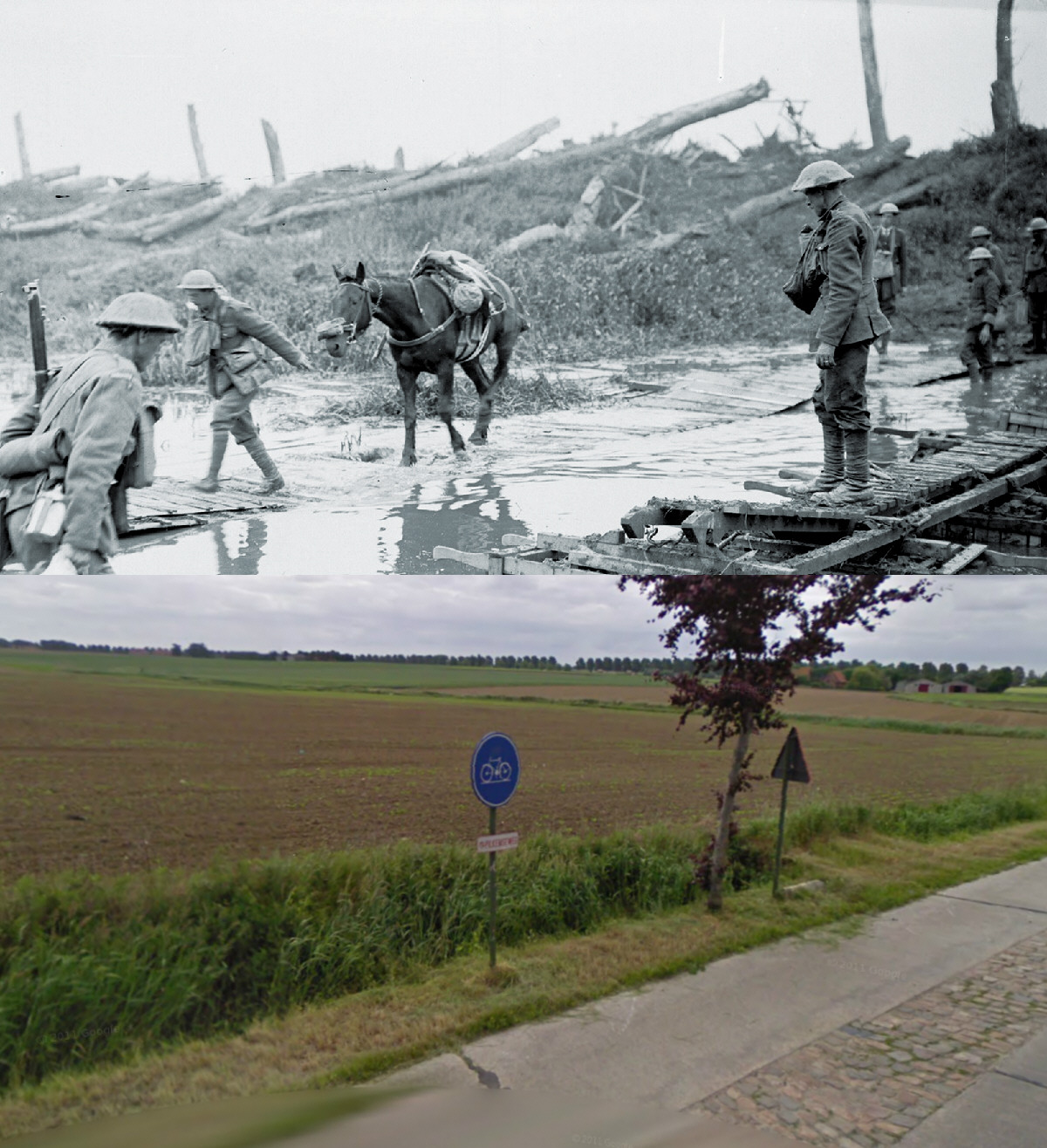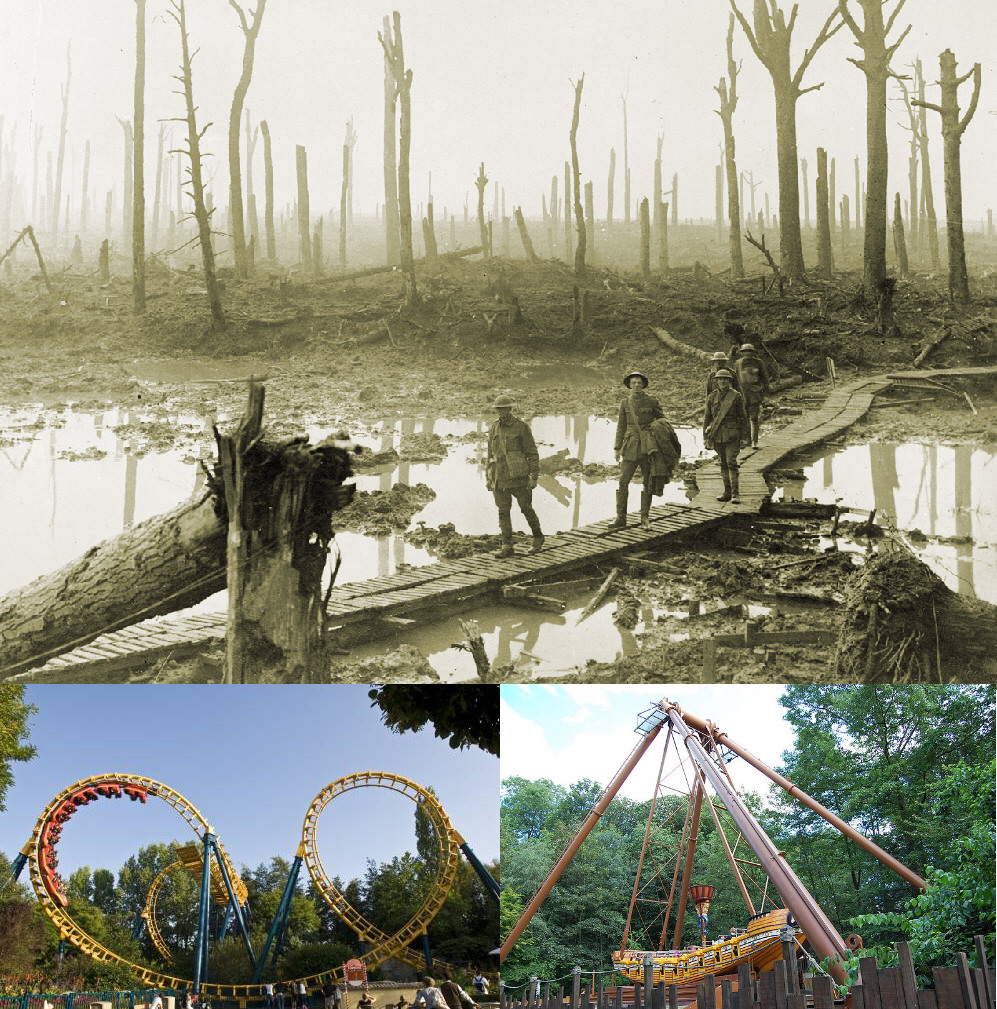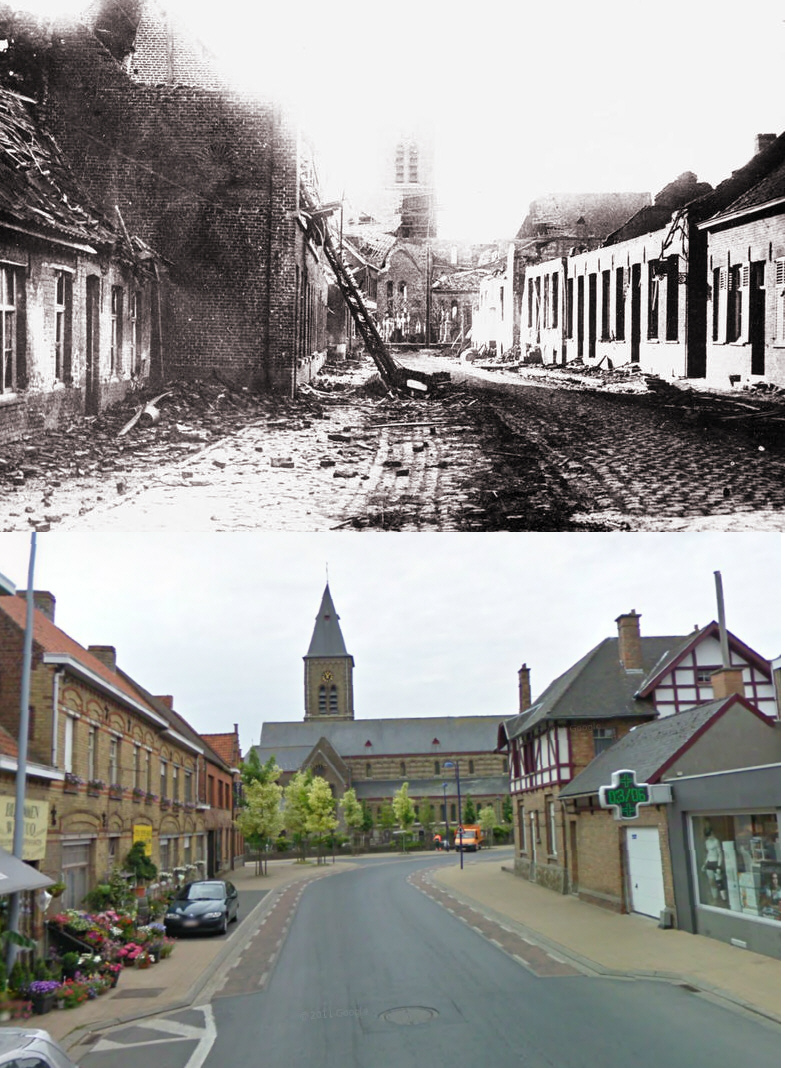
The name Passchendaele has become synonymous for waste of life and pointless orders to continue the attack irrespective of the ground conditions.
Tony Noyes, Battlefield Guide Par Excellence and Friend
Pilckem Ridge Area: When the Rain Began and Today
Click on Image to Expand
The horrendous losses to the French in their part of the Allied offensive of April 1917 had led to widespread mutinies during the summer. As a result, the
burden of continuing the attack on the Germans in the fall of 1917 fell to the British forces. Sir Douglas Haig, the British commander-in-chief, chose the
Ypres salient as the site for his new offensive. He believed this area offered the greatest scope for a breakthrough, and the Royal Navy supported him, hoping
that the army could capture the ports on the Belgian coast that the Germans were using as bases for their submarine offensive against Britain's seaborne
trade.
The offensive began on 31 July 1917, but made disappointingly small gains. The British artillery bombardment, which was needed to shatter the enemy's defensive trench system, also wrecked the low-lying region's drainage system, and unusually rainy weather turned the ground into a wasteland of mud and water-filled craters. For three months, British troops suffered heavy casualties for limited gains.
The offensive began on 31 July 1917, but made disappointingly small gains. The British artillery bombardment, which was needed to shatter the enemy's defensive trench system, also wrecked the low-lying region's drainage system, and unusually rainy weather turned the ground into a wasteland of mud and water-filled craters. For three months, British troops suffered heavy casualties for limited gains.
[Hooge] Chateau Wood: October 1917 and Today
Click on Image to Expand
On 16 August the attack was resumed, to little effect. Stalemate reigned for another month until an improvement in the weather prompted another attack on
20 September. The Battle of Menin Road Ridge, along with the Battle of Polygon Wood fought by the Australians on 26 September and the Battle of
Broodseinde on 4 October, established British possession of the ridge east of Ypres.
In October, the Canadian Corps, now commanded by Lieutenant General Sir Arthur Currie, took its place in the front lines. On 26 October the 3rd and 4th Divisions launched the first Canadian assault, in rain that made the mud worse than ever. Three days of fighting resulted in over 2,500 casualties, for a gain of only a thousand or so yards (1 km). A second attack went in on 30 October. In a single day, there were another 2,300 casualties — and only another thousand yards (1 km) gained. On 6 November, the 1st and 2nd Divisions launched a third attack that captured the village of Passchendaele, despite some troops having to advance through waist-deep water. A final assault on 10 November secured the rest of the high ground overlooking Ypres and held it despite heavy German shelling. This marked the end of the Passchendaele offensive.
In October, the Canadian Corps, now commanded by Lieutenant General Sir Arthur Currie, took its place in the front lines. On 26 October the 3rd and 4th Divisions launched the first Canadian assault, in rain that made the mud worse than ever. Three days of fighting resulted in over 2,500 casualties, for a gain of only a thousand or so yards (1 km). A second attack went in on 30 October. In a single day, there were another 2,300 casualties — and only another thousand yards (1 km) gained. On 6 November, the 1st and 2nd Divisions launched a third attack that captured the village of Passchendaele, despite some troops having to advance through waist-deep water. A final assault on 10 November secured the rest of the high ground overlooking Ypres and held it despite heavy German shelling. This marked the end of the Passchendaele offensive.
Passchendaele Village after the Battle and Today
Click on Image to Expand
Passchendaele was one of the war's most futile battles. The unspeakable conditions led to terrible losses — nearly 260,000 British casualties, including over
15,000 Canadians killed and wounded. This suffering had produced no significant gains (though it did help wear down the German army). Passchendaele
has come, perhaps more than any other battle, to symbolize the horrors of the First World War.
Sources: Imperial War Museum, Library and Archives of Canada and BBC Website
Sources: Imperial War Museum, Library and Archives of Canada and BBC Website




Y-pers, the slang for the Belgium town in the British Army. Thank Goodness the Yanks got involved in the war and showed everybody how to fight a modern war!
ReplyDeletei.e. produce a lot more than your enemy!
It worked in WW1 and WW2!
When the 'Yanks' did eventually turn up (as they did again in 1941)it was only the numbers of fresh bodies that helped. They were raw, untrained troops for the most part and spent months being shown how to function in the field by allied forces. They certainly taught NO-ONE how to fight a modern war. By the time that they spent their few weeks in action, it was all over bar the shouting and their main contribution was to be a numerical factor in undermining German morale. Oh yes, and they got as big a pasting as anyone else when they eventually saw a little bit of fighting. A welcome addition, of course, but they had little to teach anyone
Delete"When elephants war, it is the grass that suffers." My grandfather volunteered and was part of the AEF. Thank God he survived - for my sake. Whether or not the Americans added any new strategy, let us not forget, saying anything like "when the Yanks finally showed up" is a disservice to those who were slaughtered in France between 1914 and 1918 - British, French, American, German, Austrian, etc. etc. They fought because they were told to do so by their respective governments. It is the war industry, safe from the slaughter, that profited from that, and every, war. Nothing was truly gained, only the lives of so many were lost and families destroyed. Maybe the Doughboys brought no new strategies etc. but is not their flesh and blood enough? Indeed, without that contribution, would the Allies have won WW1 or WW2? This is not a prideful thing, it is a tragedy that we are today no better off in the world for people to live simple lives after so many have, and continue, to feed the machine the supreme sacrifice. Apologies. I study this war and as I do so, I connect with a grandfather I never knew, and in the process I feel the pain of ALL those who served. It's a very emotional exercise.
DeleteActually, in their first battles, the doughboys (the Yanks), did no better than the British and French. In the tragic battle of Belleau Wood, the Marines fell in greater numbers than in any Marine Corps battle to that date. Overall, the doughboys did not teach anyone how to fight, as you put it, "a modern war." Gen. Pershing, in fact, placed most of his tactical emphasis on infantry charges with rifles (he called it "open warfare.").
ReplyDeleteWhat the doughboys did -- and this is crucial and it changed history -- was to bring two million new, fresh, energetic soldiers to the Western Front. That tipped the balance of forces there, broke the deadlock and won the war. It was raw numbers that did it: not new tactics, not new strategy, but lots and lots of fresh enthusiastic troops. arriving at French ports at the rate of 10,000 per DAY.
Thank you to all the young lads who gave the ultimate sacrifice .We will never forget you.
ReplyDeleteheartbreaking
ReplyDelete